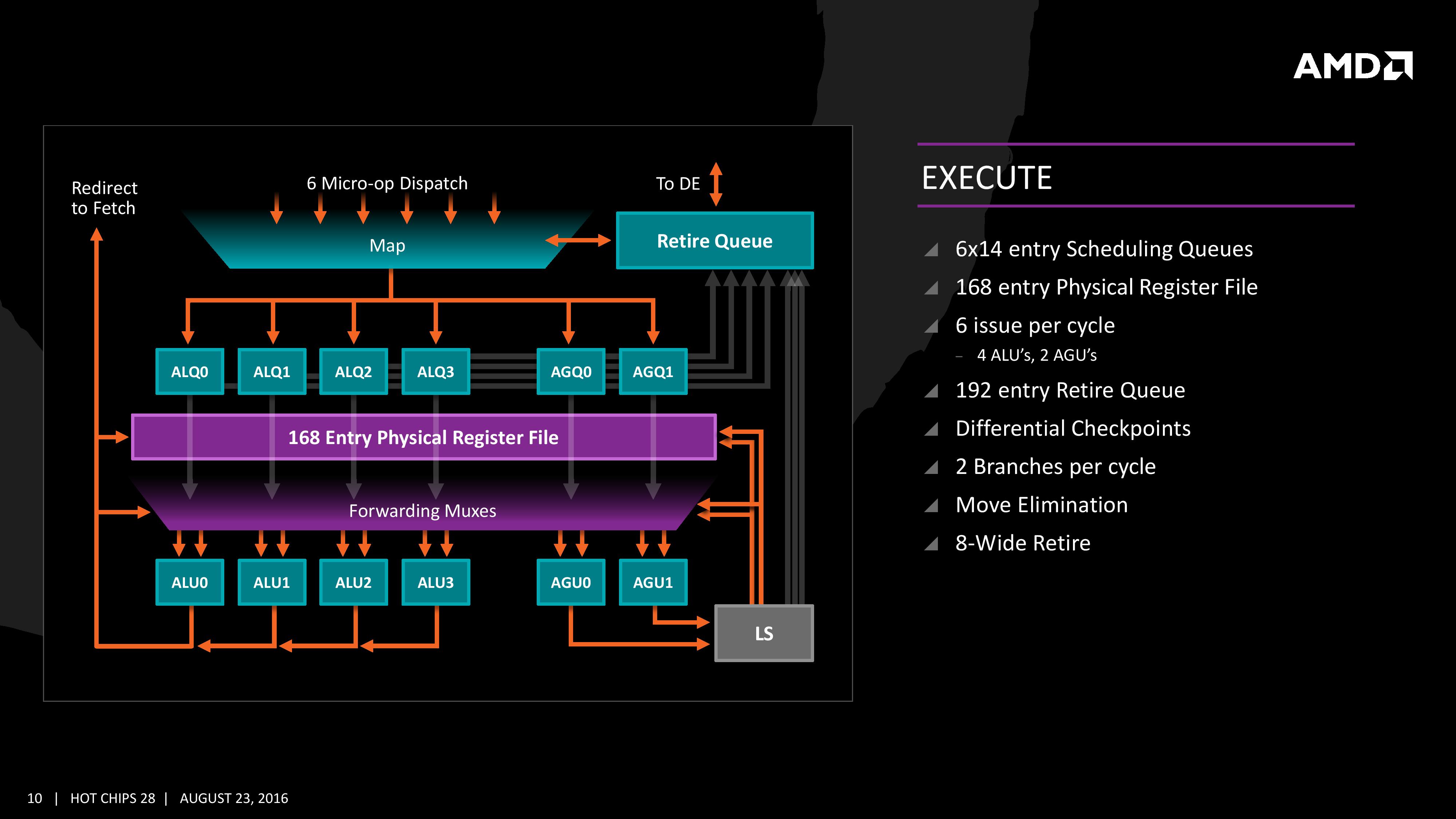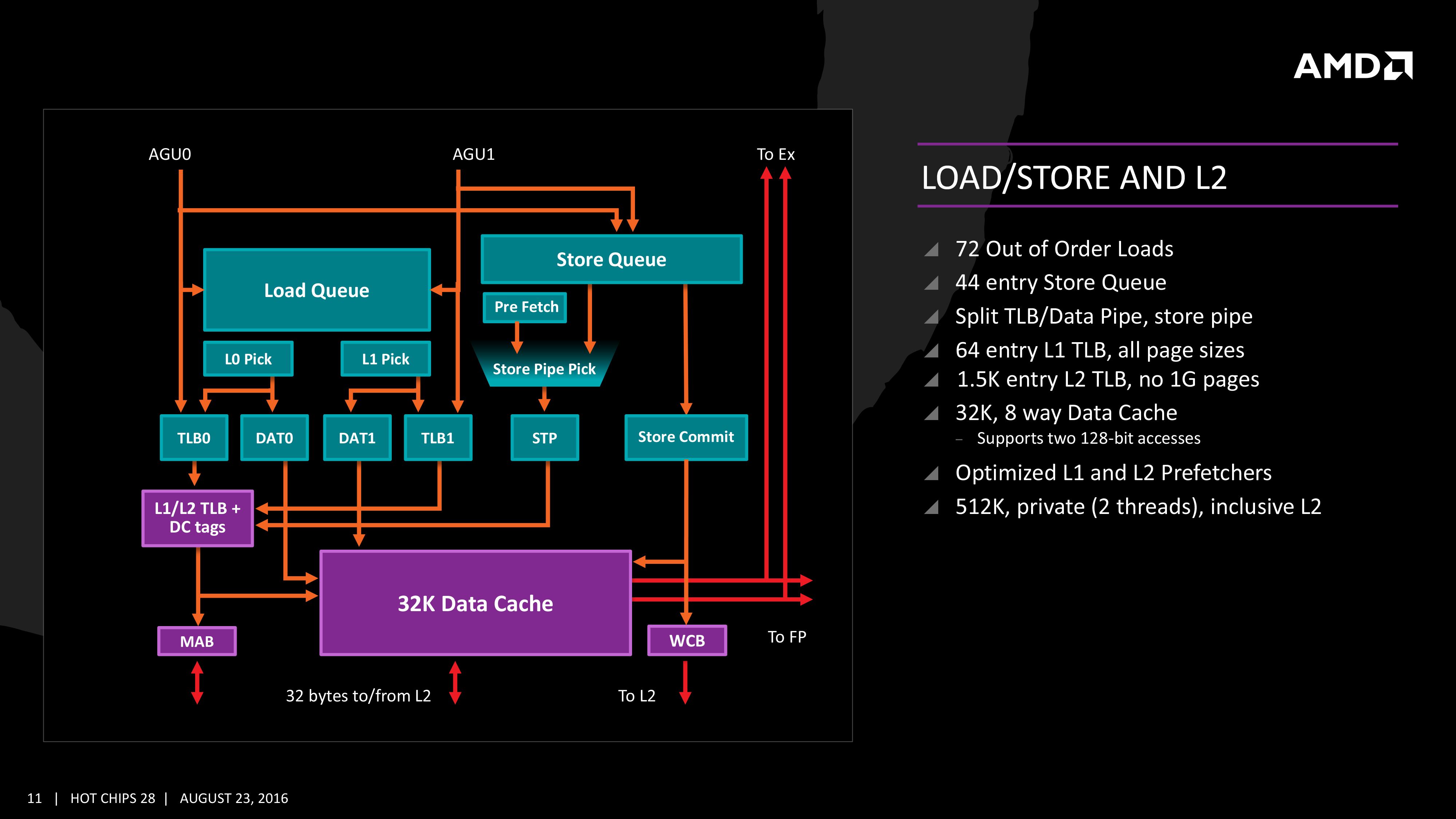AMD Zen Microarchiture Part 2: Extracting Instruction-Level Parallelism
by Ian Cutress on August 23, 2016 8:45 PM EST- Posted in
- CPUs
- AMD
- x86
- Zen
- Microarchitecture
Execution, Load/Store, INT and FP Scheduling
The execution of micro-ops get filters into the Integer (INT) and Floating Point (FP) parts of the core, which each have different pipes and execution ports. First up is the Integer pipe which affords a 168-entry register file which forwards into four arithmetic logic units and two address generation units. This allows the core to schedule six micro-ops/cycle, and each execution port has its own 14-entry schedule queue.
The INT unit can work on two branches per cycle, but it should be noted that not all the ALUs are equal. Only two ALUs are capable of branches, one of the ALUs can perform IMUL operations (signed multiply), and only one can do CRC operations. There are other limitations as well, but broadly we are told that the ALUs are symmetric except for a few focused operations. Exactly what operations will be disclosed closer to the launch date.
The INT pipe will keep track of branching instructions with differential checkpoints, to cut down on storing redundant data between branches (saves queue entries and power), but can also perform Move Elimination. This is where a simple mov command between two registers occurs – instead of inflicting a high energy loop around the core to physically move the single instruction, the core adjusts the pointers to the registers instead and essentially applies a new mapping table, which is a lower power operation.
Both INT and FP units have direct access to the retire queue, which is 192-entry and can retire 8 instructions per cycle. In some previous x86 CPU designs, the retire unit was a limiting factor for extracting peak performance, and so having it retire quicker than dispatch should keep the queue relatively empty and not near the limit.
The Load/Store Units are accessible from both AGUs simultaneously, and will support 72 out-of-order loads. Overall, as mentioned before, the core can perform two 16B loads (2x128-bit) and one 16B store per cycle, with the latter relying on a 44-entry Store queue. The TLB buffer for the L2 cache for already decoded addresses is two level here, with the L1 TLB supporting 64-entry at all page sizes and the L2 TLB going for 1.5K-entry with no 1G pages. The TLB and data pipes are split in this design, which relies on tags to determine if the data is in the cache or to start the data prefetch earlier in the pipeline.
The data cache here also has direct access to the main L2 cache at 32 Bytes/cycle, with the 512 KB 8-way L2 cache being private to the core and inclusive. When data resides back in L1 it can be processed back to either the INT or the FP pipes as required.
Moving onto the floating point part of the core, and the first thing to notice is that there are two scheduling queues here. These are listed as ‘schedulable’ and ‘non-schedulable’ queues with lower power operation when certain micro-ops are in play, but also allows the backup queue to sort out parts of the dispatch in advance via the LDCVT. The register file is 160 entry, with direct FP to INT transfers as required, as well as supporting accelerated recovery on flushes (when data is written to a cache further back in the hierarchy to make room).
The FP Unit uses four pipes rather than three on Excavator, and we are told that the latency in Zen is reduced as well for operations (though more information on this will come at a later date). We have two MUL and two ADD in the FP unit, capable of joining to form two 128-bit FMACs, but not one 256-bit AVX. In order to do AVX, the unit will split the operations accordingly. On the counter side each core will have 2 AES units for cryptography as well as decode support for SSE, AVX1/2, SHA and legacy mmx/x87 compliant code.













106 Comments
View All Comments
eldakka - Wednesday, August 24, 2016 - link
The first page link, AMD Server CPUs and Motherboard Analysis, is wrong, it actually links to the ARM v8-A article.atlantico - Friday, August 26, 2016 - link
Yes, it's also wrong here: http://www.anandtech.com/show/10585/unpacking-amds...Sigh.
TristanSDX - Wednesday, August 24, 2016 - link
Zen do not support transactional memory, big disadvantage comparing to IntelSenti - Wednesday, August 24, 2016 - link
And how much does it matter? TSX is great thing no doubt there. But the adoption? What can you name of real software what uses and get significant benefit of it?I blame Intel stupid marketing for cutting TSX from too many versions and killing the adoption.
coder111 - Wednesday, August 24, 2016 - link
As far as I know, Azul JVMs do support transactional memory. So if you have a Java app, you can use it.Other than that, yes, I haven't seen TSX used much...
68k - Wednesday, August 24, 2016 - link
Isn't the version of glibc in recent Linux-distributions using the lock elision feature of TSX?https://lwn.net/Articles/534758/
https://01.org/blogs/tlcounts/2014/lock-elision-gl...
If so, then essentially every single Linux program does make use of TSX when present.
looncraz - Wednesday, August 24, 2016 - link
One of the most important features of TSX are checkpoints. Zen supports checkpoints in its execution pipeline. Otherwise, I've not seen anything that said Zen did or did not support TSX, not that the tech is widely used at this time.From there, you just need tagging and a few other features to add support. It's something that could be included in Zen+ if Zen does not have it.
silverblue - Wednesday, August 24, 2016 - link
It looks like Zen was developed to accelerate the vast majority of software, and rely on core count for everything else. It might explain the lack of focus on AVX.If cache stats were any indication of performance, it would appear that Zen was destined to compete with Broadwell, but not quite match the Lake CPUs; Zen+ would perhaps close the gap albeit a bit late. Bulldozer was hamstrung by half-speed writes and horrific L3 latency - would it be remiss to assume that they've at least fixed those two issues?
I'm not sure anybody can truly predict performance however, even with a Blender demonstration, and certainly not to work out prospective Cinebench or SuperPi performance. You could have a monster of an architecture, but if the software isn't optimised for it, it's not going to be representative of its true performance.
wumpus - Wednesday, August 24, 2016 - link
I'd still want the TSX instructions before even thinking about the server market. I guess they surrendered that before the overall architecture was finished. Although considering how badly it has worked for Intel (essentially turned off after errata was noted in the first generation), maybe it wasn't worth risk.Alexvrb - Sunday, August 28, 2016 - link
Yeah they need to take their time. A faulty implementation would do more harm than good at this point.